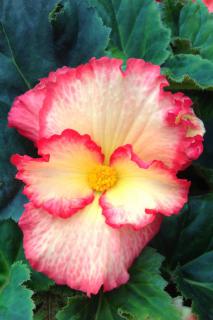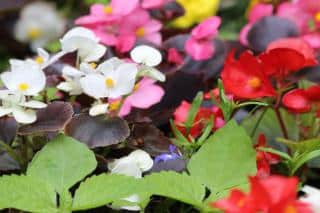

Begonia offers magnificent blooming, abundant and spectacular.
Key Begonia facts
Name – Begonia
Family – Begoniaceae
Type – annual, tuber or perennial
Flowering – May to October
Height – 8 to 16 inches (20 to 40 cm)
Exposure – full sun, part sun
Soil – rather rich, well drained
Planting and care are major factors ensuring better growth and flowering for the plant.
When planting or repotting your begonia, its best to use flower plant soil mix or a mix of leaves and soil mix.
If you’re planting the tubers directly, germinate the tubers in a pot first, hollow side facing upwards at a depth of 1¼ to 1½ inches (3 to 4 cm) early March.
Annual begonia outdoors
Sow in a tray from January to March, transplant in April and transfer to the ground during the month of May.
If you purchase it directly in a nursery pot, transfer it to the earth earliest in April.
Perennial begonia outdoors
Plant anytime from April onwards, directly in the ground, preferably in a shaded spot.
In the ground or in a garden box, keep a buffer space of about 6 to 8 inches (15 to 20 cm) between neighboring plants.

This often is carried out in November, after the blooming and when the leaves have wilted away completely.
Annuals are multiplied through sowing.
Tubers and perennials are propagated through crown or tuber division in spring.
The care that begonia requires is quite easy and only consists in very little attention, especially once it has settled in well.
Begonia enters in a dormant state when its leaves have all wilted and fallen off.
Certain varieties have evergreen leafage; for these wait until no more flowers appear.
This only relates to perennial begonia.
 This very beautiful plant native to South America gathers a great number of species that differ in hue and form.
This very beautiful plant native to South America gathers a great number of species that differ in hue and form.
It owes its name to the governor of Saint Domingue, a certain Michel Begon. Considered an herbaceous plant since it has no stem, it is part of the group of plants that are typically called bushes.
Its striking bright colors range from yellow to red and pink, and they’ll irradiate all the more that the begonia is made to grow in a good quality substrate.
If you’re growing begonia in cold-weathered winters, proceed to do the following after leaves have fallen but before the first frosts hit: bring the tubers indoors in a cool ventilated spot and clean the dirt off a bit. You’ll be able to plant them again in the following year!
Your comment is awaiting moderation.